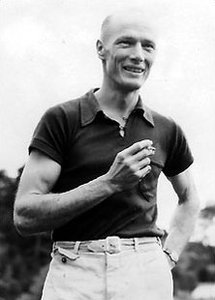Clement Hurd facts for kids
Quick facts for kids
Clement Hurd
|
|
|---|---|
 |
|
| Born |
Clement Gazzam Hurd
January 12, 1908 New York City, U.S.
|
| Died | February 5, 1988 (aged 80) San Francisco, California, U.S.
|
| Education | St. Paul's School Fernand Léger |
| Alma mater | Yale University |
| Known for | Illustration, Painting |
|
Notable work
|
Runaway Bunny series |
| Spouse(s) | Edith Thacher Hurd |
Clement Gazzam Hurd (born January 12, 1908 – died February 5, 1988) was an American artist. He is famous for drawing pictures in children's picture books. He worked a lot with writer Margaret Wise Brown. Together, they created classic books like Goodnight Moon (1947) and The Runaway Bunny (1942).
Contents
Clement Hurd's Life Story
Early Years and Education
Clement Hurd was born in New York City. His father, Richard Melancthon Hurd, was an economist. Clement went to St. Paul's School in Concord, New Hampshire. After that, he studied architecture at Yale University. He also learned painting from a famous artist named Fernand Léger in Paris, France.
His Career as an Illustrator
In 1933, Clement Hurd came back to New York. He started working as a commercial artist. This means he created art for advertisements and businesses.
Around this time, Margaret Wise Brown was an editor and writer. She worked at a company called W. R. Scott. When she saw some of Clement's paintings, she asked him if he would like to illustrate children's books.
Their first book together was Bumble Bugs and Elephants (1938). This book was special because it was one of the first "board books" for babies. Board books have thick pages that are hard to tear.
Hurd and Brown's next book was The Runaway Bunny. It was published in 1942 and has been printed ever since! This means many generations of children have enjoyed it.
Their most famous book, Goodnight Moon (1947), is a true classic. It is loved by families all over North America. By 1990, over 4 million copies had been sold. In 2007, teachers even listed Goodnight Moon as one of their top 100 books for children.
Clement Hurd also illustrated more than 50 books written by his wife, Edith Thacher Hurd. She was a friend of Margaret Wise Brown. He also drew pictures for a children's book by Gertrude Stein called The World Is Round. Clement Hurd even wrote and illustrated his own book, Run, Run, Run.
He passed away in 1988 in San Francisco after an illness.
Family Life
Clement Hurd's son, Thacher Hurd, also became a children's book author and illustrator. Thacher once said that his home in Vermont had a "wonderful aura of creativity." This shows how art was a big part of their family life.
Clement Hurd's Legacy
Clement Hurd's artwork continues to be celebrated. In 2004, an exhibition called "From Goodnight Moon to Art Dog: The World of Clement, Edith and Thatcher Hurd" was held. It showed the work of Clement, his wife Edith, and their son Thacher. This exhibition took place at the Stamford Museum & Nature Center.
Selected Works
- The World Is Round (New York: W. R. Scott, 1939), words by Gertrude Stein,
- The Merry Chase (Random House, 1941)
- The Race Between the Monkey and the Duck (Wonder Books, 1946)
- Run Run Run: Story of Black Cat and Dog (Harper, 1951),
- Margaret Wise Brown
- Bumble Bugs and Elephants (W. R. Scott, 1938)
- The Runaway Bunny (Harper, 1942)
- Goodnight Moon (Harper, 1947)
- My World (Harper, 1949), Brown – a Goodnight Moon book
- Good-night Moon Room (Harper, 1984) — pop-up book version
- Goodnight Moon's 123: A Counting Book (HarperCollins, 2007)
- Goodnight Moon's ABC: An Alphabet Book (HarperCollins, 2010)
- Edith Thacher Hurd
- Benny the Bulldozer (Lothrop, Lee & Shepard Co., 1947)
- Little Brass Band (Harper, 1955)
- Windy and the Willow Whistle (Sterling, 1956)
- Mr. Charlie, the Fireman's Friend (Lippincott, 1958)
- Last One Home is a Green Pig (Harper, 1959)
- Hurry Hurry (Harper, 1960)
- Come and Have Fun (Harper, 1962)
- Christmas Eve (Harper, 1962)
- No Funny Business (Harper, 1962)
- The Day the Sun Danced (Harper, 1965)
- Johnny Lion's Book (Harper, 1965)
- What Whale? Where? (Harper, 1966)
- The Blue Heron Tree (Viking, 1968)
- This is the Forest (Coward-McCann, 1969)
- Catfish (Viking, 1970)
- Johnny Lion's Bad Day (Harper, 1970)
- Wilson's World (Harper, 1971)
- Johnny Lion's Rubber Boots (Harper, 1972)
- The Mother Owl (Little, Brown, 1974)
- The Mother Kangaroo (Little, Brown, 1976)
- Look for a Bird (Harper, 1977)
- The Mother Chimpanzee (Little, Brown, 1978)
- Under the Lemon Tree (Little, Brown, 1980)

